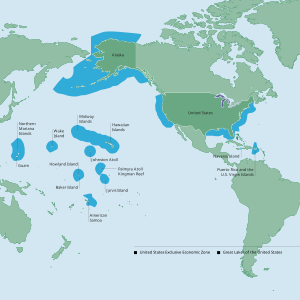Exclusive economic zone of the United States
The United States has the world's second-largest exclusive economic zone (EEZ). The total size is 11,351,000 km2 (4,383,000 sq mi)2 .[ 1] Gulf of Mexico , and the Caribbean Sea . Most notable areas are Alaska , Hawaii , the East Coast , West Coast and Gulf Coast of the United States.
Geography
Exclusive economic zone map The EEZ borders with Russia to the north west, Canada to the north, Cuba , Bahamas , Mexico to the south, Dominican Republic , British Virgin Islands , Anguilla to the south east and Samoa , Niue to the south west. The unincorporated territories of Guam , Puerto Rico , U.S. Virgin Islands and Northern Mariana Islands are included.
The EEZ (including territorial sea ) areas of the territories of the U.S. (in decreasing size)[ 2]
Territory
EEZ area (km2 )
EEZ area (sq mi)
Notes
Alaska
3,770,021
1,455,613
A non-contiguous state in the northwest extremity of the North American continent.
Hawaii – Northwestern Islands
1,579,538
609,863
Including Midway Atoll , these islands form the Leeward Islands of the Hawaiian island chain.
U.S. East Coast
915,763
353,578
The mainland coastal states of the Eastern United States .
Hawaii – Southeastern Islands
895,346
345,695
These islands form the Windward Islands of the Hawaiian island chain.
U.S. West Coast
825,549
318,746
The mainland coastal states of the Western United States .
Northern Mariana Islands
749,268
289,294
An organized unincorporated Commonwealth of the United States.
U.S. Gulf Coast
707,832
273,295
The mainland coastal states of the Southern United States .
Johnston Atoll
442,635
170,902
A National Wildlife Refuge in the U.S. Minor Outlying Islands .
Howland and Baker Islands
434,921
167,924
Including Howland Island and Baker Island , both territories are National Wildlife Refuges in the U.S. Minor Outlying Islands.
Wake Island
407,241
157,237
A National Wildlife Refuge in the U.S. Minor Outlying Islands.
American Samoa
404,391
156,136
The only inhabited unorganized unincorporated territory of the United States.
Palmyra Atoll and Kingman Reef
352,300
136,000
Both territories are National Wildlife Refuges in the U.S. Minor Outlying Islands.
Jarvis Island
316,665
122,265
A National Wildlife Refuge in the U.S. Minor Outlying Islands.
Guam
221,504
85,523
An organized unincorporated territory of the United States.
Puerto Rico
177,685
68,605
An organized unincorporated Commonwealth of the United States.
U.S. Virgin Islands
33,744
13,029
An organized unincorporated territory of the United States.
Navassa Island
N/A[ note 1]
N/A[ note 1]
A National Wildlife Refuge in the U.S. Minor Outlying Islands.
Total
11,351,000
4,383,000
Disputes
Active
Canada
A wedge-shaped section of the Beaufort Sea is disputed between Canada and the United States, because the area reportedly contains substantial oil reserves .[ 6]
Dominican Republic
EEZs in the Caribbean Sea , with American zones shaded in blue Since 2007, the Dominican Republic in Hispaniola considers itself an archipelagic state , encroaching the long-established median or equidistance line dividing the EEZ of the Dominican Republic and Puerto Rico , and claiming portion of the EEZ claimed by the United States in relation to the archipelago of Puerto Rico , which is itself an unincorporated U.S. territory .[ 7] [ 8] Victor Prescott , an authority in the field of maritime boundaries , argues that, as the coasts of both states are short coastlines with few offshore islands, an equidistance line is appropriate.[ 9]
See also
References

